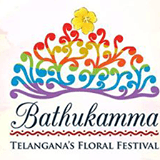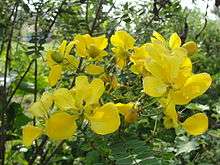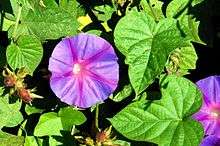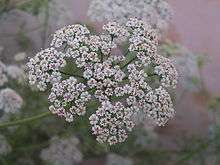Bathukamma
| Bathukamma | |
|---|---|
 | |
| Also called | Telangana's Floral Festival |
| Observed by | women of the Telangana State , India |
| Type | Spring Festival of Goddess Gauri |
| Celebrations | 9 days |
| Observances | b |
| Begins | Mahalaya Amavasya,PetharAmasa |
| Ends | Durgashtami |
| Date | September/October |
| Frequency | Annual |
| Related to | Dasara |
Bathukamma is floral festival celebrated by the Hindu women of Telangana.[1][2] Every year this festival is celebrated as per Telugu version of Hindu calendar in the Bhadrapada Amavasya, also known as Mahalaya Amavasya, usually in September–October of Gregorian calendar. Bathukamma is celebrated for nine days during Durga Navratri. It starts on the day of Mahalaya Amavasya and the 9-day festivities will culminate on "Saddula Bathukamma" or "Pedda Bathukamma" festival on Ashwayuja Ashtami, popularly known as Durgashtami which is two days before Dussehra. Bathukamma is followed by Boddemma, which is a 7-day festival. Boddemma festival that marks the ending of Varsha Ruthu whereas Bathukamma festival indicates the beginning of Sarad or Sharath Ruthu.
Bathukamma represents cultural spirit of Telangana. Bathukamma is a beautiful flower stack, arranged with different unique seasonal flowers most of them with medicinal values, in seven concentric layers in the shape of temple gopuram. In Telugu, ‘Bathukamma' means ‘Mother Goddess come Alive’ and Goddess Maha Gauri-‘Life Giver’ is worshipped in the form of Bathukamma – the patron goddess of womanhood, Maha Gauri Devi
It is the festival for feminine felicitation. On this special occasion women dress up in the traditional sari combining it with jewels and other accessories. Teenage Girls wear Langa-Oni/Half-Sarees/Lehenga Choli combining it with jewels in order to bring out the traditional grace of the attire.
The 2016 dates are September 30-October 9.[3]
History
Vemulavaada Chalukya kings were sub-feudatories of Raastrakoota kings. In the wars between Chola kings and Raastrakootas these Chalukyas sided the Raastrakootas.
In 973 AD Rastrakoota sub-feudal chalukya lord Tailapudu-2 defeated the last king Karkudu-2 of raashtrakoota kings and established independent Kalyani Chalukya kingdom. The present Telangana region was under his authority. After the death of Tailapudu-2 in 997 AD his son Satyaasrayudu became the king.
In the erstwhile kingdom of Vemulavaada (present Karimnagar District), Rajarajeswara temple is popular. Rajarajeswara received worship from Telangana people as their beloved deity.
Chola king, Paraantaka Sundara Chola was in troubles while defending the attack from Raastrakoota kings. Learning that Rajarajeswara will help those in troubles Paraantaka chola turned as his devotee.
Also, he named his son as Raja Raja. This is evident from Arikesari epigraph. Raja Raja Chola ruled between 985-1014 AD. His son Rajendra Chola attacked as a Chief of Army and stood victorious on Satyaasraya. As a sign of his victory he destroyed Rajeswara’s temple and took the Bruhat (huge) Siva linga to his father as a gift. In 1006 AD Raja Raja Chola had started building a temple to this huge Sivalinga (Brihadeswara). In 1010 AD he installed this Linga. Chola kings also announced in Tamil epigraphs that this Brihadeswara temple is built from the wealth looted in the attack on Vemulavaada Chalukya kingdom.
Even now the similarities between the Sivalinga of Vemulavaada Bheemeswaralayam and Sivalinga of Brihadeeswaralayam of Tanjavuru can be seen. Taking away the Sivalinga from Vemulavaada to Tanjavuru downhearted the people of Telangana.
After leaving Telangana in the form of Linga, along with an attempt to console Paarvathi (Bruhadamma) in the temple here and to inform sorrowfulness to Cholas, Batukamma is arranged with flowers like Meru mountain. On its top Gouramma made with turmeric is placed and is recounted with sing and play for nine days. Dispatching her in water and calling her back took a shape of a festival. Batukamma name is derived from Bruhadamma. Batukamma festival is a social denouncing movement practiced from 1000 years. Only songs are sung with mother Goddess Parvathi’s name with comforting, who is without shiva.
Preparation
On first five days women will clean their vakili (courtyard), cow dung mixed with water is spread in the courtyard as a ground-base, decorate the ground-base with managala aakara or muggu patterns or rangoli made of rice flour. For the first five days Batukamma is prepared with cow dung. Five small lumps in cone shape are arranged in the vakili.
Men in the house gather flowers from the wild plains like Celosia, Senna, Marigold, Chrysanthemum, Indian Lotus, Cucurbita leaves & flowers, Cucumis Sativus leaves & flowers, Memecylon edule, Tridax procumbens, Trachyspermum ammi, Katla, Teku Flowers, etc., which bloom in this season in various vibrant colors all across the uncultivated and barren plains of the region.
Preparing a Bathukamma is a folk art. Women start preparing Bathukamma from the afternoon. They cut the flowers leaving the little length base, some dip Gunugu (Celosia) flowers in various vibrant colours, some scented and arrange them on a wide plate called Thambalam spread with big leaves, and stack them up in a conical mound, filling the cone with leaves and stems of the flower stalks, decorated with a Lotus or Pumpkin Flower on top of the stack along with Gouramma (a symbolic idol of Gowri made of turmeric). One interesting aspect of the preparation of the flower arrangement is that the arrangement usually floats in water for sometime, and the arrangement is not disassembled until it drowns in water.
Flowers used in Bathukamma
| Flower Image | Flower Name | Telugu Name | Additional Information |
|---|---|---|---|
| |
Celosia | గునుగు | Celosia has medicinal properties: Antibacterial, Anti-inflammatory, Anti-diabetic, Wound Healing, Antioxidant.[4] Leaves of celosia, bruised and applied as poultice, are used for treating of infected sores. |
 |
Tanner's Cassia | తంగెడు | Cassia have for millennia played a major role in herbalism and folk medicine[5] |
 |
Marigold | బంతి | Marigold is a potent antiseptic herb. Several of the active chemical constituents found in the herb are fungicidal or mycotic toxins - especially the resins, in addition these compounds are also bactericidal and anti-viral agents. The roots of the Tagetes exude antibacterial thiophenes.they use different flowers |
 |
Chrysanthemum | చామంతి | It is an excellent source of antioxidants that help prevent and treat a number of diseases and disorders. It contains essential minerals like calcium, magnesium, folate, iron, sodium, potassium, phosphorus, manganese, zinc, and copper. |
 |
Indian Lotus | తామెర పువ్వు | Lotus flowers contain linoleic acid, protein, phosphorus, iron and vitamins B and C. Practitioners of ayurvedic medicine often use lotus flowers on the face for the flowers' soothing, cooling properties. |
 |
Cucurbita | గుమ్మడి పువ్వు | Used as anti-diabetic, anti-tumor, anti-hypertensive, anti-inflammatory and an anti-bacterial agent. |
| |
Cucumis | దోస పువ్వు | Used in folk medicine to treat ailments of the stomach |
 |
Ipomoea | కట్ల | A valuable medicinal plant having anti-cancer, anti-diabetic, anti-inflammatory properties. |
| |
Luffa | బీర పువ్వు | Roots is used for dropsy and as a laxative. The leaves are used to treat jaundice. |
 |
Tridax | గడ్డి పువ్వు | Antiviral, anti oxidant antibiotic efficacies, wound healing activity, insecticidal and anti-inflammatory activity. Some reports from tribal areas in India state that the leaf juice can be used to cure fresh wounds, to stop bleeding, as a hair tonic. |
 |
Ajwain | వామ పువ్వు | Reduces the gaseous effects |
much
The Ritual
For the nine days, in the evening, women, especially young girls, gather in large numbers with their Bathukammas in open areas of their locality. All women will form a circle around the Bathukamma and start singing folk songs by clapping their hands and revolving around the Bathukamma, synchronizing steps and claps in unison provide a splendorous look to the festivities. Women seek good health, prosperity and happiness for their families. The songs are to invoke the blessings of various goddesses. By principle, the rendition end with any one of the following three tributes Uyyaala - ఉయ్యాల, Chandamama - చందమామ or Gouramma - గౌరమ్మ.
Each day has a name mainly signifying the type of "naivedyam" (food offering) offered. Most of the naivedyam (food offering) offered are very simple to prepare, and usually young children or young girls are mainly involved in the preparation of the offerings for the first eight days of the festival. The last day, called saddula Bathukamma is when all the women take part in the preparation. Following is the list of names for each day and the naivedyam offered on that day. {reference: hinupad.com/9-days-bathukamma-festival/}
1) Engili pula Bathukamma- The first day of the festival falls on Mahalaya Amavasya, also known as Pethara Amavasya in Telangana region. Food offering/Naivedyam: Nuvvulu(Sesame seeds) with biyyampindi(rice flour) or nookalu(coarsely ground wet rice).
2) Atkula Bathukamma: The second day is called Atkula bathukamma, falls on the Padyami(first day) of Ashwayuja masam. Food offering/Naivedyam: Sappidi pappu(Bland boiled lentils), bellam(jaggery), and atkulu (flattened parboiled rice)
3)Muddapappu Bathukamma: The third day of Bathukamma falls on Vidiya/second day of Ashwayuja masam. Food offering/Naivedyam: muddapappu (softened boiled lentils), milk and bellam(jaggery)
4)Nanabiyyam Bathukamma: The fourth day falls on thidiya/third day of Ashwayuja masam. Food offering/Naivedyam: nananesina biyyam(wet rice), milk, and bellam(jaggery)
5)Atla Bathukamma: The fifth day falls on the chathurdi/fourth day of Ashwayuja masam. Food offering/Naivedyam: uppidi pindi atlu( pan cakes made from wheatlets), or Dosa
6)Aligina Bathukamma: The sixth day falls on the panchami/fifth day of Ashwayuja masam. No food offering is made.
7)Vepakayala Bathukamma: The seventh day falls on the sashti/sixth day of Ashwayuja masam. Food offering/Naivedyam: rice flour shaped into the fruits of neem tree is deepfried.
8)Vennamuddala Bathukamma: The eight day falls on sapthami/seventh day of Ashwayuja masam. Food offering/Naivedyam: nuvvulu(sesame), Venna(Butter) or ghee(clarified butter), and bellam(jaggery)
9) Saddula Bathukamma: The ninth day of bathukamma is celebrated on ashtami/eight day of Ashwayuja masam, and coincides with Durgashtami. Food offering/Naivedyam: Five types of cooked rice dishes: perugannam saddi(curd rice), chinthapandu pulihora saddi(tamarind rice), nimmakaya saddi(lemon rice), kobbara saddi(coconut rice) and nuvvula saddi(sesame rice)
Saddula Bathukamma
This festival is celebrated for nine days and concludes on Durgastami. The last day of the festival is called Saddula Bathukamma. On this final day immersion of Bathukamma (Bathukamma Visarjan) in water bodies is celebrated with utmost devotion and enthusiasm with rhythmic drum beats throughout Telangana. The evening offers a beautiful, calming and a peaceful visual treat. Guramma (a symbolic idol of Gowri made of turmeric) is taken back from Bathukamma before immersion and every married woman applies a paste of this, on her Mangala sutra that marks the solemnization of her marriage and also her husband is protected from all evils and ill fate.
For 9 days of festival each day a Nivedyam or a special dish is prepared and offered to the goddess. Generally ingredients of the dishes are Corn (మొక్క జొన్నలు), Sorghum (జొన్నలు), Bajra (సజ్జలు), Black Gram (మినుములు), Bengal Gram (శనగలు), Green Gram (పెసర్లు), Ground Nuts (పల్లి), Sesame (నువ్వులు), Wheat (గోధుమలు), Rice (బియ్యము), Cashew Nut (Kaju), Jaggery (బెల్లం), Milk (పాలు) etc. Maleeda - a combination of Roti and Jaggery, is prepared on this day and distributed at the end of the event.
Myth
Once upon a time, King Dharmangada of Chola Dynasty used to rule South India. After many prayers and rituals, his wife gave birth to Goddess Lakshmi. Baby Lakshmi survived many accidents. So, the parents named her Bathukamma (Bathuku = Life, Amma = Mother). Since then Bathukamma festival is celebrated by young girls in Telangana. The purpose of this festival is to pray to the Goddess in the belief that the young girls would get husbands as per their wish, to teach the young girls how to take care of their in-laws, their husbands, be great women who respect elders, love people around them, be guides to their younger ones. Further, married women celebrate the festival to pray to the Goddess for good health and prosperity of their families.
Other Versions
Bathukamma means ‘come back to life mother’ and it is an asking for Goddess Sati to return. Legend has it that Sati returned as Goddess Parvati and therefore the festival is also dedicated to Goddess Parvati.
There are many myths behind this festival. According to one myth Goddess Gauri killed 'Mahishasura' the demon after a fierce fight. After this act, she went to sleep on the 'Aswayuja Padyami', due to fatigue. The devotees prayed to her to wake up, and she woke up on the Dasami.
The other being Bathukamma, as the daughter of the 'Chola' King 'Dharmangada' and 'Satyavati'. The king and queen lost their 100 sons in the battlefield and prayed to Goddess Lakshmi to be born in their house, as their child. Goddess Lakshmi heard their sincere prayers and chose to oblige them. When Lakshmi was born in the royal palace, all the sages came to bless her and they blessed her with immortality "Bathukamma or Live Forever".
Bathukamma or 'Shakthi', according to one legend, is a lover of flowers. Flowers are arranged on a square wooden plank or a square bamboo frame with the size of frames tapering off to form a pinnacle on top. They resemble the shape of a temple 'Gopura'. Gauramma (a symbolic idol of Gowri made of turmeric) is placed on top of the flowers. This little floral mountain is worshipped as Goddess Bathukamma.
This festival is celebrated with joy and gaiety. During these celebrations, there are dance performances, music, dramas and a variety of entertainments as thousands of tourists and locals too, flock to witness the happenings. 'Jataras' are also held during this month long celebrations..
References
- A journey through change (http://www.hindu.com/thehindu/mp/2005/02/22/stories/2005022200770300.htm).
The Hindu, 22 February 2005. Retrieved 6 October 2011.
- Joys of cooking (http://www.thehindu.com/life-and-style/Food/article799015.ece), The Hindu, 27 September 2010. Retrieved 6 October 2011.
- “Goddess Gauri” (http://web.archive.org/web/20071216181412/http://www.csuohio.edu/hindu/Gauri.htm).
About Hinduism. Hindu Student Association. Cleveland State University. 2006-02-20. Archived from the original http://www.csuohio.edu/hindu/Gauri.htm) on 2007-08-11. Retrieved 2011-10-06.
- Grand finale to Bathukamma (http://www.hindu.com/2007/10/19/stories/2007101958130300.htm), The Hindu, 19 October 2007. Retrieved 6 October 2011.
Reference Book, Bathukamma Panduga Patalu Mariyu Sampradhayalu by Thatikonda Vishnu Murthy, Akunoor, Warangal Dist.,Telangana.,India.
External links
| Wikimedia Commons has media related to Bathukamma. |
